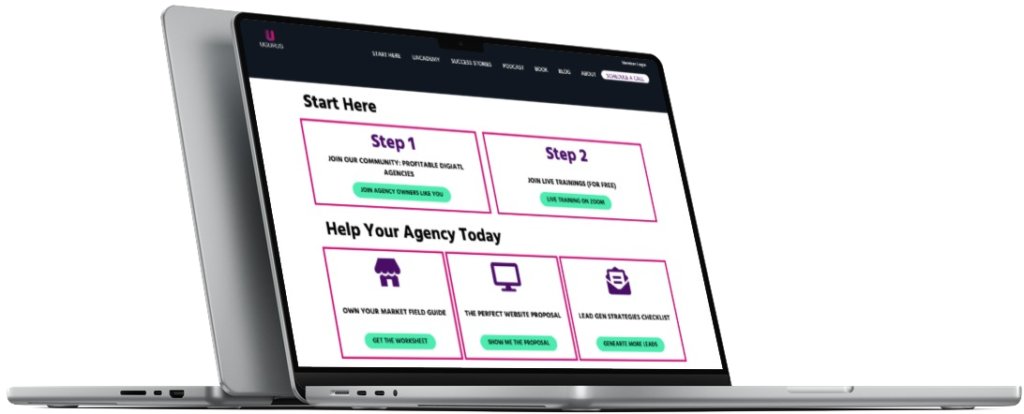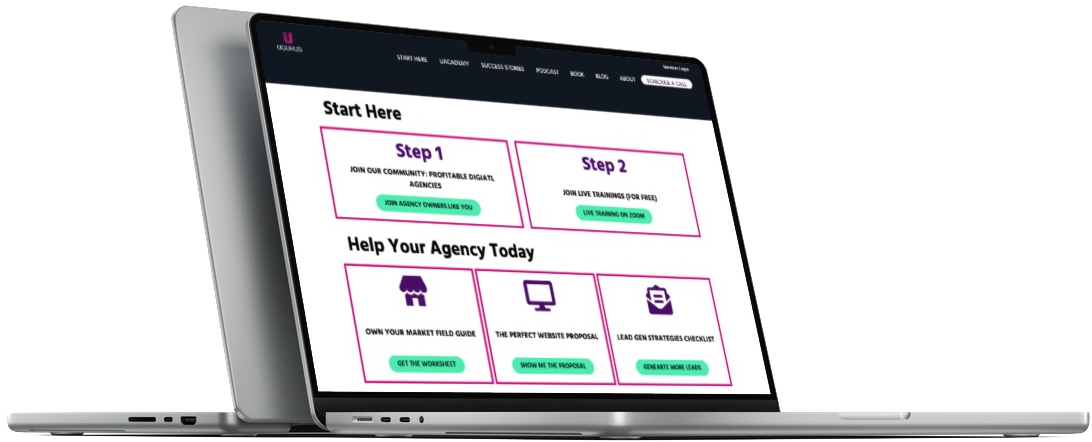A student of mine recently informed me of an idea called your bus count. Answer the question:
“How many team members can get hit by a bus without the company going bust?”
Your answer is your bus count. The higher the number, the more robust your business is to survive unexpected events.
Asking for your bus count is a brilliant question to think about regarding people on your team. Probably a wakeup call to most agency owners. In my work mentoring digital agency owners at UGURUS, I can’t wait to bring it into my repertoire of questions.
Later that day I had a call with another prospective coaching client, and the problem at hand was different, but I couldn’t help but see the relation.
He had a whale client that drove eighty to ninety percent of his monthly revenue.
It occurred to me that the bus count applied two ways. A sister-question:
“How many clients can get hit by a bus without your company going bust?”
For him, it was one. He had a whale. Like Captain Ahab, if it went under, so did he.
Quite precarious.
Why It Happens
Agencies that find themselves in this position have to first reflect on how they got there. Finding a whale client is a significant accomplishment. You’re pushing yourself by taking on a massive project. The downside, of course, is that this one client might be purchasing all of your bandwidth – including the time you spent marketing and selling to find said whale client.
Whales bring a false sense of security. All of a sudden you can pay all of your bills, your people are busy, and cash is flowing into your business. You can take your foot off the gas pedal. Give yourself a bonus or raise. Take that vacation you’ve been putting off.
Then, your next order of business becomes caring for this whale. Making sure you deliver and delight so your whale stays on past the honeymoon period. They likely will. Whale clients prefer to sit and deplete a food source. You’re their food source. They will eat you until they finish the last morsel.
After a while your marketing and sales muscles atrophy. You begin to spend time doing things outside your business, like picking up that hobby you’ve so ignored. The days of endless hustle begin to fade. You stop working on your business.
Months pass. Sometimes years.
Then it happens. You wake up in a cold sweat in the middle of the night realizing what’s happened. You’ve become a team of contracted employees for another business.
Good or Bad Fit
On the surface, whales are your big break. A new high watermark for your agency. The question at the heart of this conversation is a basic one that every agency needs to answer before considering a whale for their business:
“What is your core business model?”
Answering this question, you should look at a few things:
- Ideal customer profile
- Revenue model
- Target project size
- Proven process
- Accountability chart
Getting a whale client starts with getting a whale opportunity. No one forces you into a contract with a client that will absorb the lion’s share of your agency’s resources. When you get that opportunity, you have to consider if this is a big break into that level of client, or if this is an anomaly. The choice is yours, not the market. There are plenty more whales out in the world if you go looking.
Choosing to serve your typical client and then have this one big client is a sure path to a client bus number of one over the long run. However, if you plan to add additional clients like your whale to your roster, then a whale can be your path to scaling your agency.
Serving two groups of customers, one group being one customer, the other your smaller, typical client, means you have two business models. The work you do to support them will operate differently than the rest of your clients.
Back when I was running my agency, we got a big contract with Dish Network. It was a blank check. I could put all of my people on the account, bill as much as we could handle – even overtime – and they still wanted more. However, the process they had us work in was vastly different from the rest of our clients. We had different reporting schemes, had to bill a certain way, and they required us to turnaround work almost daily.
Dish had so much work for us we even gave our team open-ended overtime opportunities. Great in the short run, bad when you have a team that’s worked nights and weekends for a month straight. Other projects started to suffer.
While the money was great, it created a tsunami of disorder for the rest of our clients. Deadlines started getting pushed for our other clients. We started scheduling everything around Dish. After just a month our business began to organize around a single client. Burnout began setting in.
We pulled the plug. I could see the writing on the wall. If we continued down this path, our reputation would suffer, and the health of our agency would be at risk.
It was clear that this client was outside the business model we had built. We had no intention of finding more clients like them. If we had, then this could have been a launch pad. I had seen too many agencies fall into this trap, and I was committed to avoid it.
A Simple Prescription
If you find yourself in a position where you have a single client that’s providing most, if not all, of your agencies income, you need to take action immediately. No, don’t go off and fire that client or have a conversation with them.
You need to rediscover the hustle you once had. You need to get back to treating your business like a business and not the high paying job it’s become. That means investing time working on your company again. The good news is you have a steady stream of income that will support you – for now.
Like exercise and diets, working on your business is most effective when done a little bit in regular intervals, and you maintain discipline over a medium to long period. You’ll get better results if you workout three times a week for an hour than if you workout once a month for a whole day.
You can’t fix this problem in a day. In a week. Or even in a month. Taking your eye off your whale will put your business at risk, so don’t panic.
My recommendation is pretty simple:
Block out the first ninety minutes of your day, every day, to work on your business.
An hour is too little. More than an hour and you’re going to cut into other work priorities. If 100% of your work time is taken up by your whale client and other work obligations, ninety minutes is a small enough time that you can find it in other places (give up watching TV, wake up earlier, cutout breaks, or the leisurely lunch your whale affords you).
Doing this work first thing is essential. Don’t fall into the trap of giving your business the leftovers. Or saying, “when I finish all of my other work, then I’ll get to my stuff.”
You won’t.
If you work on your business first – just like putting on your oxygen mask on first, then those around you – you’ll nourish it with your best ideas and focus. Then you’ll be able to work on your client work in a better mood knowing that you’ve done significant work for yourself. You won’t have to work with that nagging feeling that the other shoe is going to drop any day now. And this will benefit the quality of the work you do for your clients.
The Momentum Benefit
After two to three months, your ninety-minute discipline will start to pay off. After two or three years, you’ll be a force to reckon.
I could go into all sorts of strategies and tactics on what to do with this time. How to work backward from your whale’s “customer avatar” to find more… how to discover your niche and sign a lot more ideal clients… how to start advertising or build an email list.
All are excellent ideas and things that you should consider.
However, you’ll learn all that stuff in your ninety minutes a day. Likely much more. Just like the person who wants six-pack abs by spring break. While the individual workouts are sort of important, the leading indicator is easy to measure: the number of days in the gym each week working out intensely for at least an hour.
The novice is the one who seeks the tricks and shortcuts. The pro knows they need to drill and drill often.
Ryan Holiday, in Ego is the Enemy, quotes a martial artist by the name of Daniele Bolelli:
“…training was like sweeping the floor. Just because we’ve done it once, doesn’t mean the floor is clean forever. Every day the dust comes back. Every day we must sweep.”
Getting a whale client and resting on our marketing and sales laurels is sweeping once and being done. You did something good back when you signed this big client. You were out networking, following up with leads, or some other form of marketing.
Turns out, in life, showing up gets you eighty percent of the way there. Just giving your business that dedicated time, being disciplined about it, and sticking to the routine will create momentum way beyond your whale client situation.
So start sweeping. Increase your client bus number beyond one. You never know when that bus is going to show up and you’ll want to survive when it does.
GET YOUR FREE AGENCY ACCELERATOR PACKAGE






